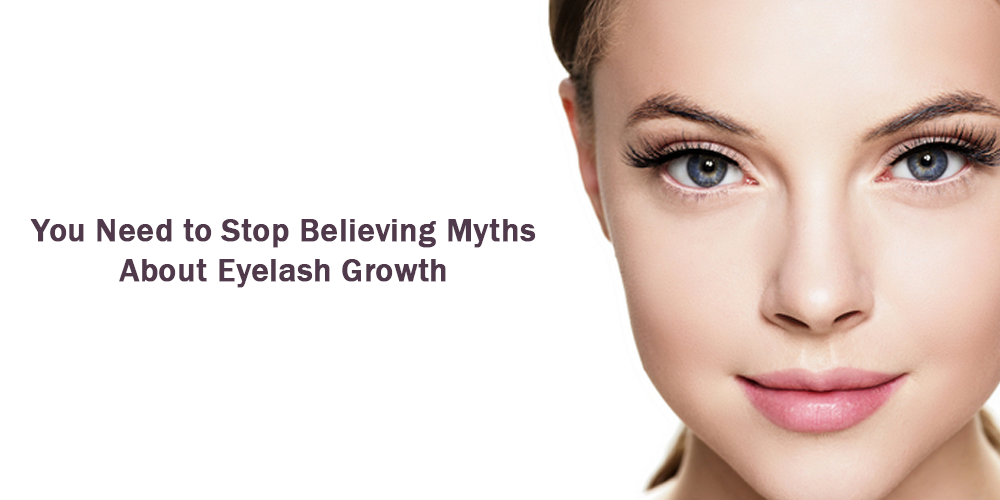“The eyes are the windows to the soul,” they say. Women spend a lot of time making sure that their eyes look perfect. Long and full lashes are a huge part of it. Most people are looking for ways to make eyelashes grow longer and thicker as we see all the celebrities on social media.
But the truth of the matter is that when they post selfies, the stars that we follow online are hardly in their natural state. False lashes adorn nearly every celebrity and social media star’s eyes.
So, while we’re talking about truths, let’s talk about some of the eyelash growth “methods” that’s just flat-out myths. From coconut oil for eyelashes to petroleum jelly and more you’ve probably heard about it all. Let’s get right now to the bottom of these common myths.
Here are 4 common myths about how your eyelashes are supposed to grow faster and longer.
Myth 1: Use Vaseline On Your Lashes
This is a very common myth because Vaseline smearing on your lashes makes them all oily and glossy reflecting the light. This may seem as if some have grown their lashes. Yet petroleum jelly has very large molecules which, let alone the hair follicle, can not even penetrate the skin.
Simply, vaseline can not stimulate hair growth, and many reputable beauty therapists and ophthalmologists will beg you not to use it around your sensitive eye area. Vaseline is called petroleum jelly because, as you inferred, it is refined from petrol. Would you like to bring it so close to your eyes?
Vaseline can be a good dry skin barrier cream as it seals in moisture, but it can’t do more than just stay on the skin.
Natural oils such as castor oil and coconut oil have been called “miracle oils” in many blogs.
Myth 2: Apply Natural Oils To Your Lashes
Due to its low molecular size, Castor oil, unlike Vaseline, can easily penetrate deep into the skin. That’s right. But there is absolutely no credible clinical evidence linked with claims that castor oil can stimulate circulation and thus promote hair growth. Even if it is capable of nourishing the skin and hair, hair growth is not the same. The skin and hair are nourished by many beauty products.
Coconut oil is another intensely moisturizing product that can be a great remover of eye makeup. It is also shown to minimize hair protein loss and its fatty acids can protect hair from breakage.1 However, there is zero evidence to indicate that it may affect development.
Like Vaseline, coconut oil as well as castor oil are glossy and reflect light. A small bit brushed onto eyelashes might make them look fuller and longer, but it’s just an illusion.
Myth 3: Regularly Brush Your Lashes
Separating the lashes and brushing or combing the hair upwards will make them look neater and fuller–and, yes, much longer. But if you overdo it, you’ll probably take out more hair than you might be willing to fall out naturally.
Think about the phases listed above. Tugging constantly at the lashes in the telogen, and particularly during the catagen phases, will only cause them to fall out faster than if you were to handle them carefully.
Constant brushing and combing can also result in more hair shaft damage itself–which will definitely not help in longer lashes. When you feel the need to do so, stick to combine certainly.
Myth 4: Trim Your Lashes
Are you crazy?! Put down the sharp scissors! However, if you poke your eye out, the least of your concerns will be your lashes.
You don’t have to prune your eyelashes! Although some people believe that when it is regularly cut, the hair on their heads will grow faster, that too is a misconception. All cuts are neatening up the split ends that make hair look thicker and healthier.
Every hair has a naturally occurring growth cycle in four parts:
Anagen Phase: This is when hair is developing aggressively. From the hair follicle, the hair shaft is growing in length.
Telogen Phase: This is the stage of resting when the hair is still attached to the follicle but not growing. That length will remain until it sheds.
Catagen Phase: This is a brief period of rapid degeneration of the tissue. Just before the hair is shed, this process occurs. We are in the catagen process where the hair is naturally lost (without being pulled out).
Neogen Phase: The neogenic phase signals fresh regrowth after a hair shed to restart the cycle. The tissue and stem cells in and around the follicle strongly influence this process. Therefore, it is important to note that in this process your skin (which houses your hair follicles) also plays an important role.
Please note that at a certain length your eyelashes (like other hairs on your body) enter the phases of the telogen and catagen, and it is very unlikely you will do anything about this cycle. For the most part, eyelash development is written in your genetics.
Still, Want Thicker Lashes?
The Careprost eye drop is an ophthalmic component that is remotely used as a topical solution to the condition called eyelashes hypotrichosis. In order to make the flimsy, thin eyelashes soft, long and thick, a Careprost eye drop is effectively used along these lines. The reduction in the eye of Careprost is also a valuable treatment to recover glaucoma in patients. Buy Careprost 3ml as it is a beautiful prescription system designed to reduce hypotrichosis issues. This striking eye drop treats the slight and scanty condition of hypotrichosis eyelashes.

